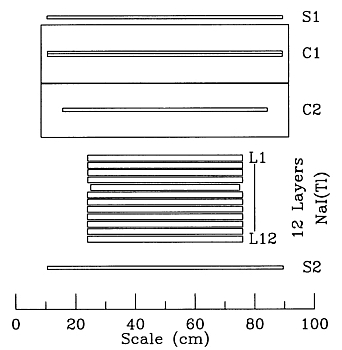Purpose of the flight and payload description
HEIST was the acronym for High Energy Isotope Spectrometer Telescope, a balloon-borne instrument developed primarily to measure the isotopic composition of galactic cosmic rays, focusing on elements such as boron (B), carbon (C), nitrogen (N), and oxygen (O). Its primary objective was to obtain high-precision measurements of isotopic abundances at energies higher than those achieved by previous direct mass measurements, specifically in the range of approximately 400-780 MeV per nucleon. These measurements aimed to shed light on cosmic-ray source abundances and possible nucleosynthetic processes distinct from those that shaped the solar system. The instrument was developed through a collaboration between the California Institute of Technology (Caltech) and the New Mexico State University.
HEIST (which can be seen schematically in the drawing at left) employed a sophisticated set of detector components. It contained a stack of 12 NaI(Tl) scintillators, each 2 cm thick and 52 cm in diameter, to measure the total energy of stopping nuclei. The instrument determined particle trajectories by analyzing the distribution of scintillation light across six photomultiplier tubes assigned to each NaI(Tl) layer, achieving a positional accuracy of about 4 mm for the nuclei of interest. To measure the velocity of incoming nuclei, HEIST used two Cherenkov counters: C1, with a Teflon radiator corresponding to a threshold energy of 442 MeV/nucleon, and C2, with a Pilot-425 radiator providing a threshold of 305 MeV/nucleon. A plastic scintillator (S1) provided an event trigger and a charge identification measurement through energy loss detection, while a second scintillator (S2) identified penetrating events.
Each event analyzed by HEIST yielded three independent charge measurements and two or three mass measurements, depending on the particle's energy. Charge measurements utilized the correlation between energy deposition (dE/dx) and Cherenkov light, and the mass was determined by methods combining Cherenkov response with total energy deposition, as well as through the energy loss versus residual energy technique. Only particles stopping within the NaI(Tl) stack were considered candidates for mass analysis. By combining multiple mass estimators, HEIST achieved a mass resolution of approximately 0.24-0.27 atomic mass units (amu) across the elements analyzed.
Details of the balloon flight
Balloon launched on: 8/26/1988 at 2:17 utc
Launch site: Prince Albert Airport, Saskatchewan, Canada
Balloon launched by: National Scientific Balloon Facility (NSBF)
Balloon manufacturer/size/composition: Zero Pressure Balloon SF3-392.73-080-NSCR
Balloon serial number: W23.50-3-04
Flight identification number: 255N
End of flight (L for landing time, W for last contact, otherwise termination time): 8/27/1988 at 16:00 utc
Balloon flight duration (F: time at float only, otherwise total flight time in d:days / h:hours or m:minutes - ): 38 h
Landing site: 25 miles E of Trochu, Alberta, Canada
External references
- A Cerenkov-delta E-Cerenkov detector for high energy cosmic ray isotopes and an accelerator study of Ar-40 and Fe-56 fragmentation. Ph.D. Thesis California Inst. of Tech.; Lab. of Physics.; Pasadena, CA, United States
- Launch in Canada Concludes Successful Cosmic Ray Campaign Goddard News, November 1988, p. 3
- Recent results in the NASA research balloon program 27th Aerospace Sciences Meeting, 1989
- The isotopic composition of cosmic-ray B, C, N, and O - Evidence for an overabundance of O-18 Astrophysical Journal, Part 2 - Letters, vol. 391, no. 2, p. L89
2647If you consider this website interesting or useful, you can help me to keep it up and running with a small donation to cover the operational costs. Just the equivalent of the price of a cup of coffee helps a lot.


